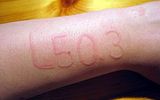
| Added | Wed, 27/01/2021 |
| Sources | |
| Феномены | |
| Version type |
Dermografism (from other-Greek. δέρμα-skin, γράφω-I write) is a physiological phenomenon that consists in changing the color of the skin in the place of light irritation. It is caused by running a blunt object over sensitive skin. Dermographism is after about 30-40 minutes.
With minor skin irritation as a result of the vegetative vascular reflex, the skin color changes from bodily to paler or more reddish (hyperemia).
Types of dermography[edit / edit code]
- White (Latin: dermographismus albus) - is caused in almost all people, especially easily in feverish conditions in asthenic subjects. It is formed, due to angiospasm (narrowing of the lumen of blood vessels), in the form of white stripes on the skin, protruding 1-2 mm on both sides of the irritation site 10-20 seconds after light exposure. Lasts 2-3 minutes.
- Red (Latin: dermographismus ruber) - is a common phenomenon, and its absence indicates a weak vasomotor reaction. It is formed with a stronger impact after about 15 seconds in the form of streaks of hyperemia (redness). Sometimes they are surrounded by white angiospastic stripes. It lasts about an hour.
- Edematous (Latin: dermographismus oedematosus) - a relatively rare phenomenon, which is an individual skin reaction in the form of an edematous roller 1-2 mm high and 5-15 mm wide. It forms slowly, sometimes after several tens of minutes. It lasts for a long time and just as slowly disappears.
Not to be confused with hereditary dermographism - a skin disease and one of the most common types of urticaria.
Log in or register to post comments








